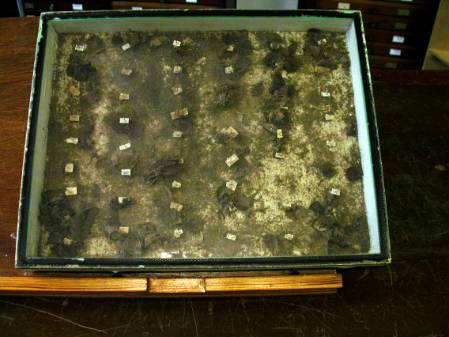We have been in the new building a couple of weeks now and things appear to be calming down. I have started sending out loans again as previously we held off on them due to the time involved to sort them out. Today I sent some of the largest Asilids (robber flies) from our collection to Belgium to be worked on. I do hope that they will get there ok. Each specimen is cross-pinned to ensure that it does not move around. The box is then sealed with cellophane and then this box is put in another box. It should be ok but we have had many an abdomen lost (not that anything is going anywhere for a while...). I have many current loans and many overdue loans. I have one that is overdue from 20 years ago and it is only one fly! I find it hard to believe that people take that long to look at one specimen. The more probable answer is that they have lost the material and do not want to disclose this fact! I would much prefer that they stated this though rather than being stuck in limbo! A few of us our discussing an elite loan recovery squad to jet off round the world, abseiling into museums, labs etc to find the missing specimens
Two of my colleagues and I did our first Nature live in the new Attenborough Studio last Thursday night. We were talking about flies, parasitic lice and parasitoids. It was nice to have a session that did not lookat all the traditional insects that everyone thinks of as cute or beautiful,and actually point out that these groups are incredibly important and show them some amazing specimens. Gavin Brood (the parasitic hymenopterist) did bringalong the worlds smallest insect so maybe they didn't get to see so much of some of them!! I brought along a Darwin specimen of a Therevid that was sent back along with many others from Valpariso, Chile. The fly had seen better days with three legs, a wing and its antenna missing!! We talked about the collection, collecting techniques and our individual areas of research. The public seemed to enjoy it and one was even heard commenting on the way out that they had no idea that scientists were witty . I guess the reason why we do this public outreach is the demystify ourselves as well as our work...
Below is a picture of some butterflies (honest). I used it to demonstrate that you can't just leave the collection, it needs to be checked regularly!!
I have some Brazilian visitors over here at the moment looking at the Diptera collection. They both work at the University of Sao Paulo although at different departments within it with one of them working as the Head of Invertebrates at the Museum there. They have been impressed so far with the building and the collection. But already one has been working on unidentified material and found new species! The Brazilian Government has spent a lot funding the study of Taxonomy and it is obvious in the standard of researcher (we have many masters students requesting our material) that we see. They will be here for the next couple of weeks so I am hoping for a few more new species turning up
Right, off to an all day meeting.....



